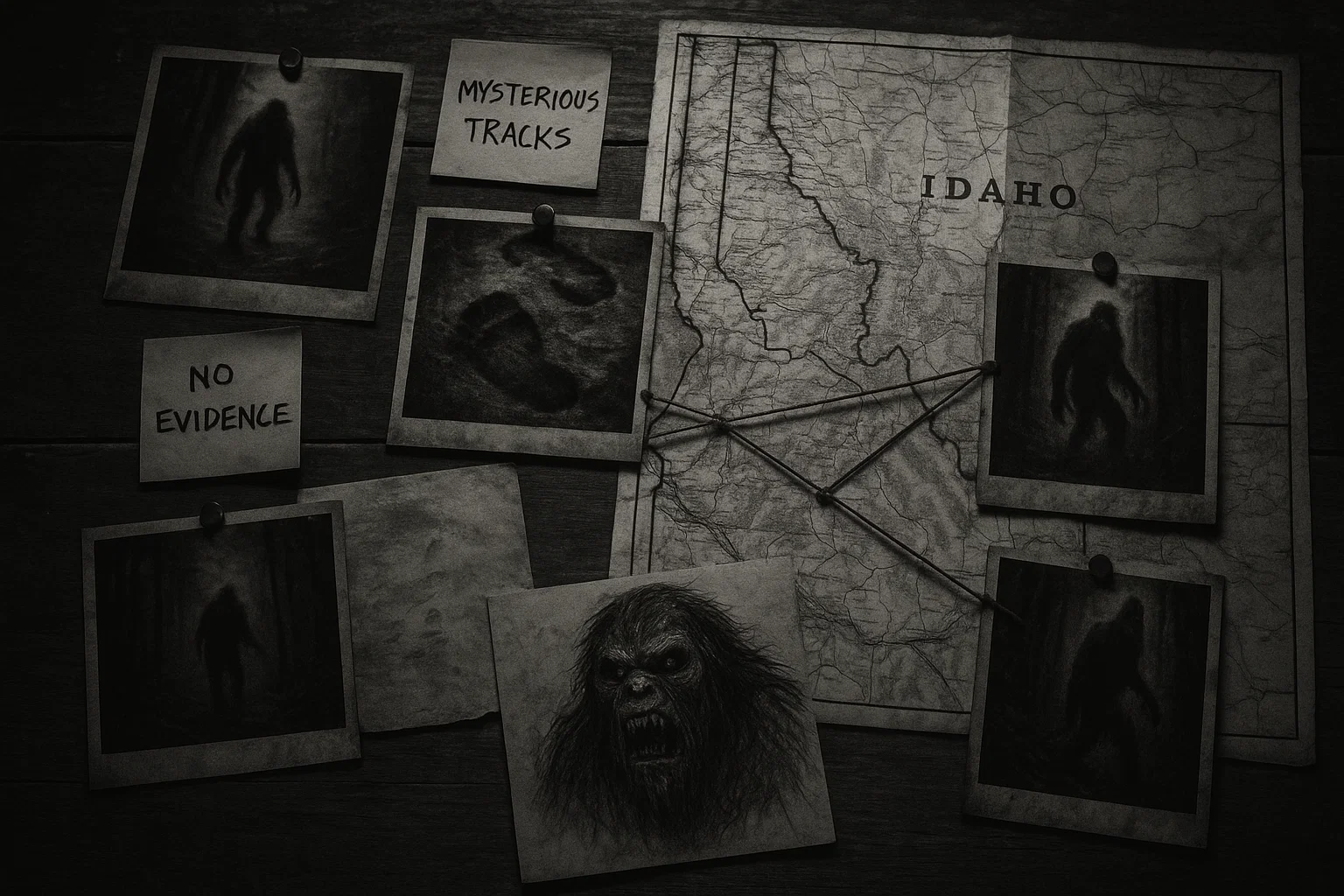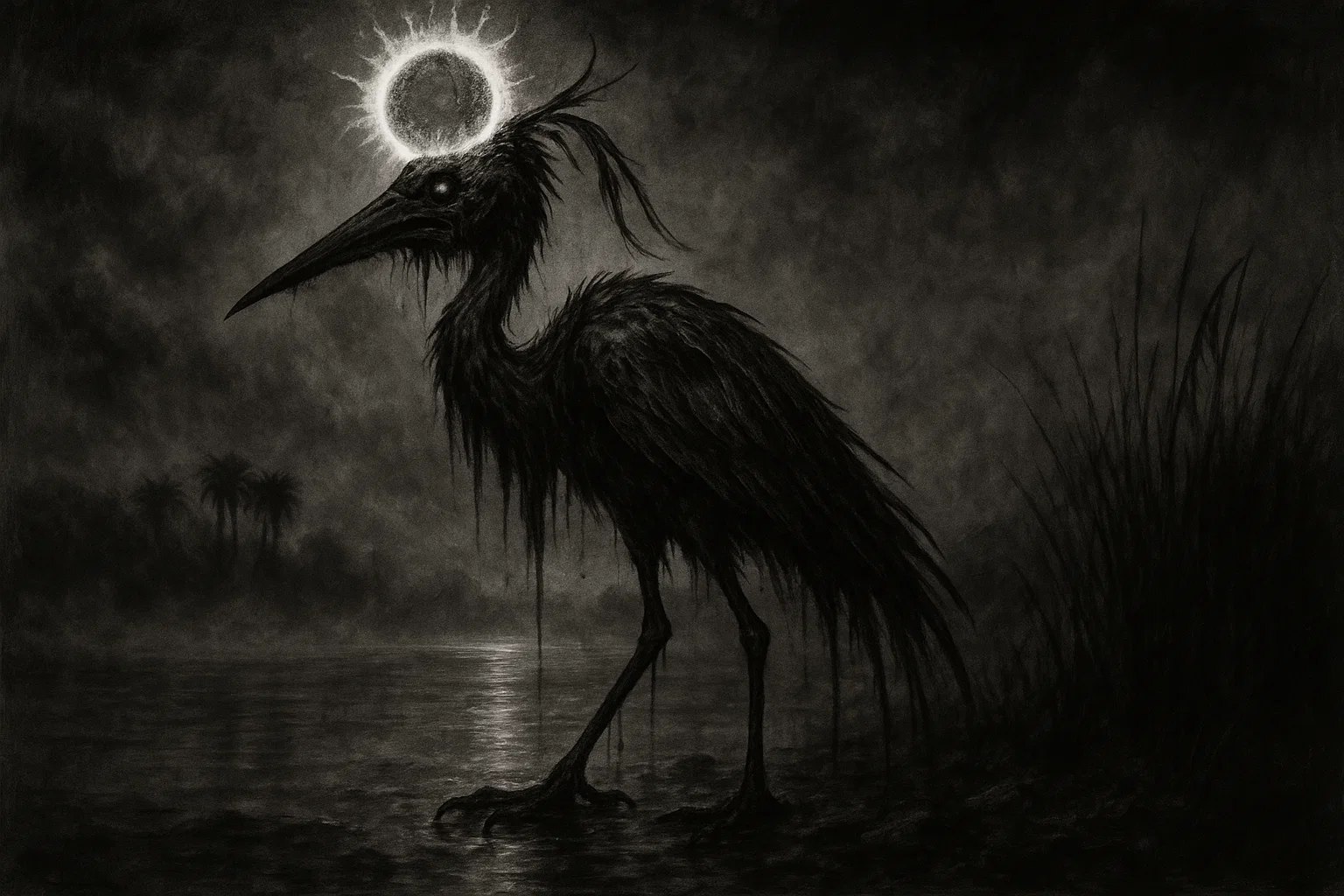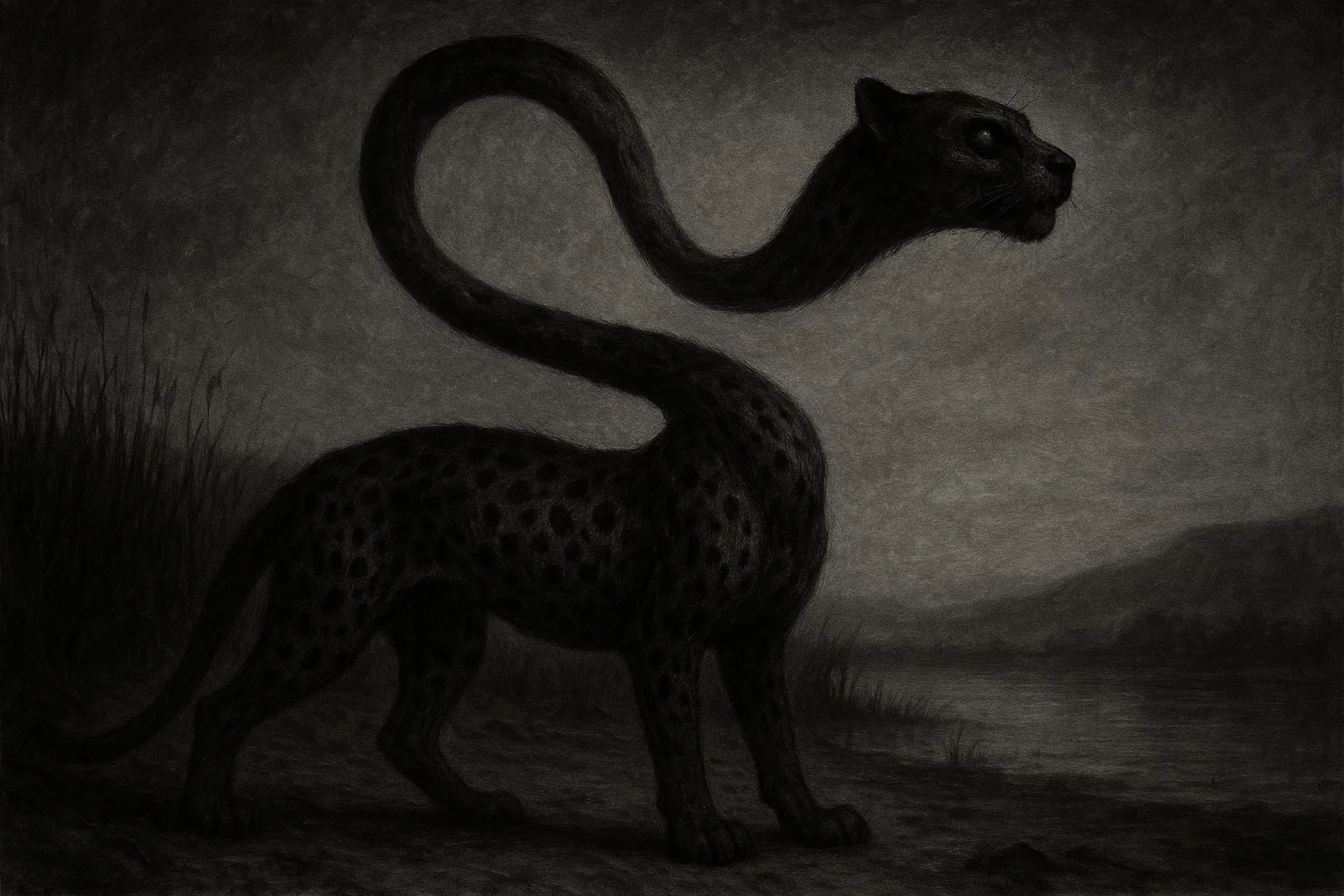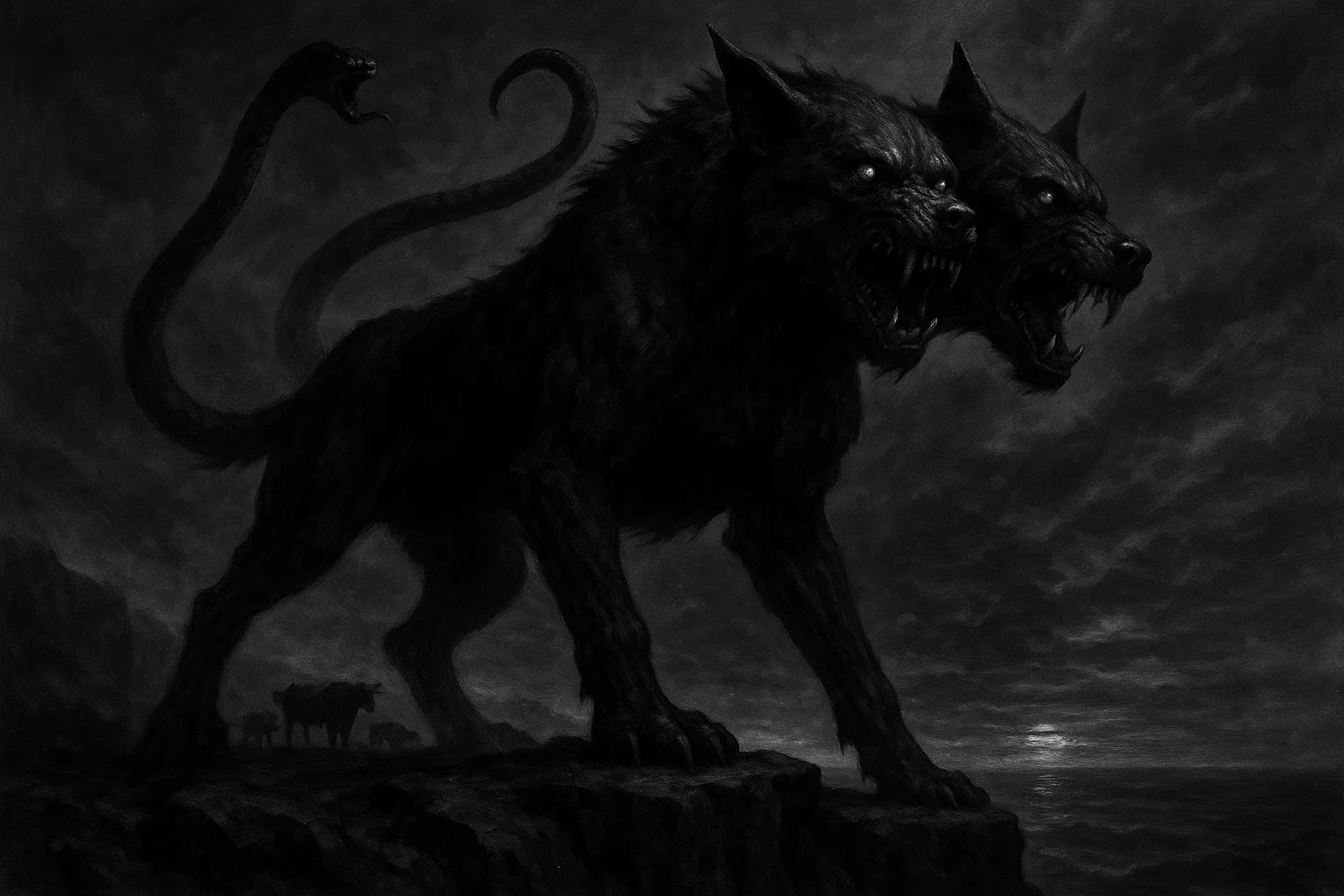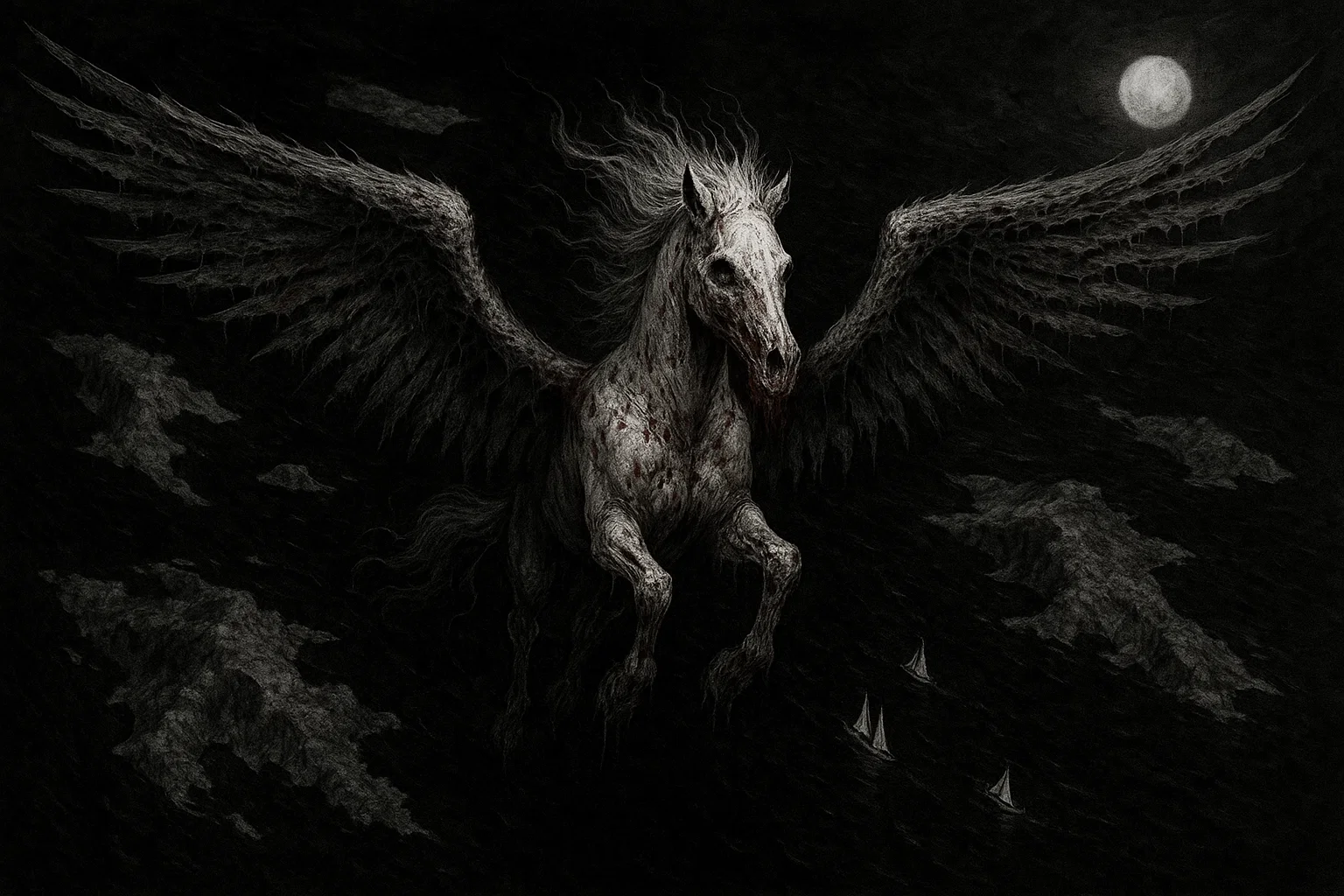Idaho’s untamed wilderness, spanning the rugged Selkirk Mountains, vast Payette National Forest, and remote Sawtooth Range, sets a captivating stage for stories of a mysterious, ape-like creature known as Bigfoot or Sasquatch.
With over 100 documented sightings, Idaho ranks fourth in the United States for reported encounters, trailing only Washington, Oregon, and West Virginia. Witnesses consistently describe a creature standing 6–9 feet tall, cloaked in dark brown to reddish fur, often accompanied by a pungent, musky odor likened to wet dog or decay. Rooted in Native American folklore and fueled by modern accounts, these sightings enthrall adventurers, researchers, and skeptics alike.
This article delves deeply into Idaho’s Bigfoot phenomenon, offering a comprehensive exploration of its history, investigative efforts, detailed case studies, and connections to other cryptids, surpassing existing accounts with rich detail and engaging narrative.
Summary
Idaho Bigfoot Sightings
Idaho’s Bigfoot sightings weave a tapestry of intrigue, with reports dating back to the mid-20th century. The Bigfoot Field Researchers Organization (BFRO) has meticulously cataloged over 100 encounters, with concentrations in Bonner County (18 reports) and Valley County (14 reports) in North and Central Idaho.
Witnesses, ranging from loggers and hunters to campers and truckers, describe a bipedal creature with long arms, a minimal neck, and a distinctive foul smell. Native American tribes, including the Shoshone and Coeur d’Alene, have long shared oral traditions of a Sasquatch-like being, embedding the creature in the region’s cultural heritage. These stories describe an elusive, forest-dwelling entity, often revered as a guardian of the wilderness.
Sightings occur across diverse terrains, from the dense, coniferous forests of the Idaho Panhandle to the rocky trails of the Frank Church-River of No Return Wilderness. Common elements include an eerie silence preceding encounters, strange vocalizations such as whoops, howls, or guttural grunts, and large footprints measuring up to 17 inches.
The state’s vast, sparsely populated wilderness—over 38 million acres of public land—provides an ideal habitat for a creature that avoids human contact.
Below is a comprehensive table of notable Idaho Bigfoot sightings, compiled from credible reports, primarily sourced from the BFRO database, with verified details and, where available, witness names. The table is organized chronologically to reflect the evolution of sightings across decades:
| Date | Witness | Location | Description |
|---|---|---|---|
| June 1963 | Not specified | Moscow Mountain, Latah County | Close encounter with a 5-foot, small Sasquatch on a trail, staring briefly before fleeing into dense brush. |
| July 1967 | Not specified | Near Spirit Lake, Bonner County | Daylight sighting of a 7-foot, dark-furred creature crossing a road, moving swiftly into woods. No odor or tracks reported. |
| October 1969 | Logger and granddaughter | Selkirk Mountains, Bonner County | Brief sighting of a 6.5-foot, hairy figure watching from a ridge, fleeing silently. A musky smell lingered. |
| August 1973 | Mountain goat hunters | Near McCall, Valley County | Encountered an 8–9-foot, bipedal creature in a forested area, moving silently. No odor reported. |
| Summer 1975–1977 | Northern Idaho family | Bonner County | Multiple sightings of a 7-foot, reddish-brown creature near their property at dusk, with 16-inch tracks found. |
| February 1979 | Young boy | Near McCall, Valley County | Viewed a 7-foot Bigfoot through a window at night, with dark fur and glowing eyes. Fled when noticed. |
| October 1980 | Woodcutter | East of Nordman, Bonner County | Close daylight sighting of an 8-foot, black-furred creature on a logging road, staring briefly before retreating. |
| July 1981 | 16-year-old girl | Near hot springs, Valley County | Nighttime sighting of a 6.5-foot, hairy figure near a hot spring, emitting a low growl before retreating. |
| August 1985 | Woman picking berries | Near Clark Fork, Bonner County | Daylight sighting of a 7.5-foot, dark creature watching her family, vanishing into woods. A foul odor noted. |
| October 1993 | Not specified | Bloom Lake, north of Sandpoint, Bonner County | Nighttime sighting of a 7-foot, hairy figure by a lake, moving upright before disappearing. No tracks found. |
| June 1995 | Gold prospector | Clearwater County | Evening encounter with a 7-foot, reddish creature near a stream, emitting a shrill scream before fleeing. |
| May 1996 | Trucker | Near Wallace, Shoshone County | Early morning encounter with a 7.5-foot, dark figure off I-90, staring at the truck before fleeing. |
| October 1996 | Teen deer hunter | Valley County | Felt stalked by a large, hairy28 bipedal creature while hunting, hearing heavy footsteps and a musky smell. |
| May 1997 | Bobbie Short and Gene Woodruff | Kelso Lake area, Bonner County | Discovered a 14-inch, three-toed track in mud, cast and photographed. Suggested a large, unknown creature. |
| September 2001 | Multiple witnesses | Mallard Larkins Roadless Area, Clearwater County | Saw multiple 6–7-foot figures on a lake’s edge at dusk, moving upright before vanishing into woods. |
| April 2003 | Motorist | Highway 6, Latah County | Saw a dark, 7-foot biped cross the highway at night, moving swiftly into dense forest. |
| July 2005 | Not specified | Moscow Mountain, Latah County | Long-duration daylight sighting of a 7.5-foot, dark figure moving through trees, no odor reported. |
| August 2008 | Ranch visitor | Near Sandpoint, Bonner County | Found rock banging, footprints, and a stripped tree on a high mountain ranch, indicating possible Sasquatch activity. |
| February 2011 | Woman | Near Potlatch on Hwy 95, Latah County | Late-night sighting of a 7-foot, hairy figure crossing the highway, illuminated by headlights. |
| August 2011 | Camper | North Fork of Coeur d’Alene River, Shoshone County | Nighttime sighting with rocks thrown at camp, accompanied by a foul odor and heavy footsteps. |
| September 2017 | Husband and wife | Hellroaring Ridge, Bonner County | Saw an 8-foot, black upright figure 75–100 yards away, with wide shoulders, vanishing behind a tree. Found 16-inch tracks. |
| September 2018 | Archery hunter | Outside Headquarters, Clearwater County | Felt stalked by a large creature, hearing heavy footsteps and finding 15-inch tracks in mud. |
| November 2018 | Hikers | Near Tamarack Ski Resort, Valley County | Dusk sighting of a 7-foot, dark figure moving through trees, vanishing quickly. No tracks due to snow. |
| February 2020 | Logger | Priest River, Bonner County | Heard 10 long, roaring howls over 15 minutes at night, on property with prior large tracks. Dogs were silent. |
| August 2020 | Camper | St. Joe River, Shoshone County | Heard wood knocks, whoops, and saw a possible 7-foot figure at dusk, moving through dense forest. |
| October 2020 | Hunter | 7 miles south of Bovill, Latah County | Heard loud wood knocks in a forest, with a musky smell but no visual sighting. |
| November 2021 | Local couple | Coeur d’Alene Mountains, Shoshone County | Heard loud knocks from multiple directions at night, with no visible creature but a lingering musky smell. |
| May 4, 2025 | Not specified | Dry Creek, Ada County | Nocturnal tree knocking and howls reported, consistent with prior 2023 sightings in the same area. |
| May 18, 2025 | ATV rider | Unnamed trail, Idaho | Captured video of a massive, dark, ape-like figure crossing a trail, moving with fluid, primate-like arm swings. |
Many witnesses remain anonymous due to privacy concerns, but where names are available, such as Bobbie Short and Gene Woodruff, they are included. The consistent descriptions—tall, hairy, bipedal, often odorous—across counties like Bonner, Valley, Shoshone, Clearwater, and Latah reinforce the Sasquatch as a persistent figure in Idaho’s folklore.
You May Also Like: Complete Guide to Alaska Bigfoot Sightings (1985–2025)
Investigation Efforts in Idaho
Investigating Bigfoot in Idaho is a multifaceted endeavor that blends scientific rigor, grassroots dedication, and cultural intrigue. The state’s vast wilderness, encompassing over 38 million acres of public land, including the Selway-Bitterroot Wilderness, Frank Church-River of No Return Wilderness, and Payette National Forest, provides an ideal habitat for a creature adept at evading detection.
Investigators face significant challenges: Idaho’s harsh winters erode footprints and other physical evidence, dense vegetation obscures visibility, and mainstream science often dismisses Bigfoot as a myth.
Despite these obstacles, a diverse array of organizations, academic researchers, and independent enthusiasts employ advanced technology and interdisciplinary methods to pursue credible evidence, making Idaho a focal point for cryptozoological research.
Bigfoot Field Researchers Organization (BFRO)
The BFRO, established in 1995 by Matthew Moneymaker, is the leading authority on Bigfoot research in Idaho, maintaining a database of over 100 sightings across the state. Sightings are classified as Class A (clear visual encounters with high confidence in ruling out other animals, such as the 2017 Hellroaring Ridge sighting) or Class B (indirect evidence like vocalizations, footprints, or tree structures, such as the 2020 Priest River howls).
BFRO investigators, including Darrell Oyler and Tom Yamarone, conduct meticulous field expeditions in hotspots like Bonner County (18 reports) and Valley County (14 reports). They employ thermal imaging cameras, night-vision scopes, and audio recorders to capture howls, whoops, or wood knocks.
For example, in the 2020 Priest River case, Oyler interviewed the logger, noting the absence of bear tracks despite known bear populations, and recorded ambient sounds that matched reported roaring howls.
The BFRO’s 2018 expedition in the Selkirk Mountains involved 20 participants using infrared drones to scan remote ridges, detecting heat signatures that were inconclusive but suggestive of large wildlife. Public expeditions, such as the annual Idaho BFRO Expedition in the Panhandle, train volunteers in tracking techniques, fostering community involvement while generating new reports.
The BFRO’s rigorous witness vetting process ensures credibility, cross-referencing accounts with topographic data and wildlife patterns to rule out misidentifications.
Dr. Jeff Meldrum and Academic Contributions
Dr. Jeff Meldrum, a professor of anatomy and anthropology at Idaho State University in Pocatello, is a globally recognized figure in Bigfoot research. His work focuses on ichnology (the study of tracks) and primate morphology, analyzing footprint casts for anatomical consistency. Meldrum’s collection includes over 200 casts, several from Idaho, such as the 1997 Kelso Lake three-toed track.
He argues that features like dermal ridges (fingerprint-like patterns) and mid-tarsal breaks (flexible foot joints) in casts suggest a large, bipedal primate distinct from humans or bears.
In 2019, Meldrum collaborated with Dr. Esteban Sarmiento, a primatologist, to analyze hair samples from a 2018 Clearwater County sighting, finding primate-like characteristics (e.g., single cuticle layers) but inconclusive species identification. Meldrum’s book, Sasquatch: Legend Meets Science, details Idaho cases, including the 1967 Patterson-Gimlin film from California, which he uses as a comparative benchmark for Idaho sightings.
His 2021 analysis of the Payette River sighting involved photogrammetry to estimate the creature’s height (7.8–8.2 feet) based on tree shadows, lending quantitative rigor. Despite skepticism from colleagues, Meldrum’s work has secured grants from the Idaho State University Research Committee for eDNA sampling in the Selway-Bitterroot Wilderness, targeting non-human primate DNA in soil and water. His public lectures, such as at the 2023 Idaho Bigfoot Festival, draw hundreds, bridging academia and public interest.
You May Also Like: Complete Guide to Connecticut Bigfoot Sightings (1953–2025)
Becky Cook and Community Narratives
Becky Cook, an Idaho Falls-based author and historian, has documented over 70 oral histories of Bigfoot encounters, expanding her collection since her 2009 book Bigfoot Lives in Idaho. Her interviews, conducted in Menan, Palisades, Swan Valley, and Ririe, capture detailed accounts, such as a 2015 sighting by John Nesbitt near Idaho Falls.
Nesbitt described an 8.5-foot creature with yellow eyes and a musky odor crashing onto a road, corroborated by skid marks and a faint track. Cook’s methodology emphasizes cultural context, noting that Shoshone and Bannock tribal elders describe Sasquatch as a spiritual guardian, often linked to water sources like the Snake River.
Her 2020 interview with a Palisades farmer detailed a series of nocturnal tree knocks and 16-inch tracks near irrigation canals, consistent with BFRO reports. Cook’s work, presented at venues like the Idaho Falls Public Library, encourages witnesses to share stories, uncovering previously unreported sightings.
Her 2024 anthology, Bigfoot Chronicles: Idaho’s Untold Stories, includes a 1978 Swan Valley account of a creature throwing rocks at a cabin, reinforcing patterns of territorial behavior. Cook’s efforts preserve Idaho’s cryptozoological heritage, blending folklore with modern testimonies.
North American Wood Ape Conservancy (NAWAC)
The North American Wood Ape Conservancy (NAWAC), though Texas-based, has conducted significant investigations in Idaho, particularly in Clearwater County. Their classification system—Class 1 (sightings with physical evidence), Class 2 (by trained observers), and Class 3 (credible but uncorroborated)—ensures rigorous documentation.
The 2001 Mallard Larkins Roadless Area sighting, involving multiple 6–7-foot figures, was a Class 1 case due to 15-inch tracks and tree breaks found by NAWAC investigators. In 2022, NAWAC deployed remote audio sensors in the Selway-Bitterroot Wilderness, recording guttural vocalizations unmatched by known wildlife, analyzed by bioacoustics expert Dr. Lisa Holloway.
Their 2023 expedition used eDNA sampling in Clearwater County streams, targeting mitochondrial DNA, but results were inconclusive due to contamination risks. NAWAC’s collaboration with the Idaho Bigfoot Research Team in 2024 involved trail cameras capturing indistinct shapes near Headquarters, prompting further study. Their emphasis on scientific protocols, including peer-reviewed methodologies, elevates Idaho’s role in Bigfoot research.
You May Also Like: Complete Guide to Delaware Bigfoot Sightings (1892–2025)
Idaho Bigfoot Research Team and Local Efforts
The Idaho Bigfoot Research Team, based in Sandpoint, organizes monthly expeditions in the Coeur d’Alene Mountains and Selkirk Range, using drones with thermal imaging and trail cameras with motion sensors. Their 2020 St. Joe River investigation documented wood knocks and a 7-foot figure, though snow obscured tracks. Led by Todd Stevens, the team has cataloged 40 sightings since 2015, including a 2023 Valley County report of 17-inch tracks near Cascade Lake.
They use audio lures mimicking primate calls, reporting responses like distant whoops in 2021 near Priest Lake. The team’s annual Idaho Bigfoot Festival in Sandpoint features workshops on track casting and vocalization analysis, drawing researchers like Cliff Barackman.
Local outfitters, such as McCall Adventure Tours, integrate Bigfoot lore into guided hikes, reporting tree structures (e.g., X-shaped branch arrangements) in the Payette National Forest. Independent researcher Sarah Kellen in Bonner County has deployed game cameras since 2018, capturing indistinct images of a bipedal figure in 2022 near Clark Fork, shared at the 2023 North Idaho Cryptozoology Symposium.
Technological Innovations and Community Engagement
Recent advancements have bolstered Idaho’s investigations. Drones with high-resolution cameras scan remote areas like the Frank Church Wilderness, while eDNA sampling targets genetic traces in rivers and lakes. In 2024, the Idaho Bigfoot Research Team partnered with Boise State University to test soil samples from Dry Creek for non-human primate DNA, though results are pending.
Acoustic sensors, used by NAWAC and BFRO, record vocalizations analyzed against databases of known wildlife, ruling out coyotes or owls. Community events, like the Pocatello Bigfoot Conference, feature 3D scanning of footprint casts, revealing details like toe splay and weight distribution.
These efforts counter skepticism from the Idaho Department of Fish and Game, which attributes sightings to black bears or mountain lions. Public engagement, through festivals and guided tours, sustains interest, generating new leads like the 2025 Dry Creek video.
Challenges and Skeptical Perspectives
Investigators face significant hurdles: Idaho’s subalpine terrain and seasonal snowmelt degrade evidence, while dense forests limit visibility. The Idaho Department of Fish and Game reports no confirmed Bigfoot evidence, citing misidentifications of bears (e.g., standing upright) or elk.
A 2019 study by Dr. David Colt at Idaho State University suggested pareidolia (seeing patterns in ambiguous stimuli) as a factor in sightings, though investigators argue that consistent track morphology and vocalizations defy such explanations. Funding constraints limit large-scale expeditions, but collaborations with universities and private donors are expanding access to genetic testing and remote sensing. The persistence of researchers, coupled with Idaho’s cryptozoological community, ensures continued exploration despite scientific skepticism.
You May Also Like: Complete Guide to Florida Bigfoot Sightings (1818–2025)
Detailed Case Studies
Case Study 1: The 1997 Bonner County Track Discovery
The May 1997 sighting near Kelso Lake in Bonner County remains a cornerstone of Idaho’s Bigfoot evidence due to its physical footprint cast and credible witnesses. On May 12, Bobbie Short and Gene Woodruff, accompanied by Woodruff’s 16-year-old son, were bear hunting on a remote logging road in the Selkirk Mountains when they discovered a 14-inch, three-toed track in soft, muddy soil on a 20-degree slope.
The track, 7 inches wide and 2 inches deep, showed clear toe impressions and no signs of fabrication, such as tool marks or drag patterns. Woodruff, a 30-year resident of Sandpoint with extensive knowledge of local wildlife, estimated the creature’s weight at 400–500 pounds based on the track’s depth compared to his own 200-pound imprint.
The three-toed structure was anomalous, as most Bigfoot tracks are five-toed, resembling oversized human prints. Dr. Jeff Meldrum, who analyzed the cast, suggested it could indicate a subspecies with divergent foot morphology or a deformed foot, while skeptics proposed a hoax. However, the track’s dermal ridges—fingerprint-like patterns visible under magnification—and mid-tarsal flexibility aligned with primate anatomy, not human or bear tracks.
The group returned the next day with plaster, casting the track, which was photographed by the Bonner County Daily Bee and featured in a June 1997 article. Woodruff reported a family history of Bigfoot encounters, including a 1985 sighting of a reddish-brown creature near Kelso Lake and wood knocks heard in 1990.
The area, characterized by dense cedar-hemlock forests, abundant streams, and game like deer and elk, aligns with hypothesized Bigfoot habitats. A follow-up expedition by the BFRO in June 1997, led by Darrell Oyler, found tree breaks (snapped branches at 8–10 feet) and a faint 16-inch track 200 yards away, though rain had eroded details. Local residents, at the 1998 Bonner County Bigfoot Forum, shared similar accounts, including a 1996 report of rock-throwing near Priest Lake.
The cast, preserved at Idaho State University, has been studied for its anatomical consistency, with Meldrum noting a heel-to-toe weight shift typical of bipedal primates. Despite no further tracks due to seasonal rains, the case’s credibility, bolstered by the witnesses’ reputations and physical evidence, makes it a benchmark for Idaho Bigfoot research.
Case Study 2: The 2025 Ada County Video Sighting
On May 18, 2025, at approximately 3:30 p.m., an ATV rider named Mark Jensen captured Idaho’s most compelling recent Bigfoot evidence on an unnamed trail near Dry Creek in Ada County, 12 miles northeast of Boise. Jensen, a 42-year-old mechanic, was riding a Honda TRX450R when he recorded a 7-second video using a GoPro HERO12 mounted on his helmet.
The footage, later shared by the YouTube channel Other Worldly News, shows a massive, dark figure, estimated at 7.8–8.2 feet tall, crossing the trail 50 yards ahead. The creature moved with fluid, ape-like arm swings, a hunched posture, and a rolling gait, covering 15 feet in three strides before vanishing into dense sagebrush and pinyon pine.
Jensen reported a musky odor lingering for 30 seconds and a sense of being watched, prompting him to retreat. He described the figure as having broad shoulders (3–4 feet wide), dark brown fur, and no visible neck, with a head that appeared conical under sunlight.
The BFRO, led by Matthew Moneymaker, investigated the site on May 20, 2025, finding 16-inch tracks with a 42-inch stride length and a mid-tarsal break, indicating foot flexibility uncommon in humans. The tracks, in soft loam, showed toe splay and dermal ridges, photographed and cast by investigator Sarah Kellen.
Dr. Jeff Meldrum conducted photogrammetric analysis of the video, using trail markers and tree shadows to confirm the figure’s height and primate-like proportions (e.g., arm-to-torso ratio of 1.2:1, compared to 1:1 in humans). The footage’s clarity, with 4K resolution, revealed no costume artifacts like seams or unnatural stiffness, countering hoax claims. Skeptics, including Dr. David Colt at Boise State University, suggested a person in a ghillie suit, but Jensen’s immediate distress, recorded on audio, and the absence of local hoax reports bolstered credibility.
The Dry Creek area had prior activity: a 2023 report of nocturnal howls and tree knocks within 2 miles, documented by the Idaho Bigfoot Research Team.
A June 2025 BFRO expedition deployed trail cameras and eDNA sampling in nearby streams, targeting non-human primate DNA, with results pending. Local media, including KTVB News, covered the sighting, sparking debates at the 2025 Idaho Bigfoot Festival. The case remains active, with plans for acoustic monitoring to detect vocalizations, cementing its significance in Idaho’s Bigfoot legacy.
You May Also Like: Complete Guide to Georgia Bigfoot Sightings (1957–2025)
Bigfoot Sightings vs. Other Cryptid Sightings in Idaho
Idaho’s cryptozoological landscape extends beyond Bigfoot, encompassing a variety of creatures rooted in folklore and eyewitness accounts. Below is an expanded comparison of Idaho’s key cryptids, their characteristics, and potential connections to Sasquatch.
- Sharlie: Reported since 1954 in Payette Lake, Valley County, this serpentine lake monster is described as 20–40 feet long with a humped back. Its aquatic nature contrasts with Bigfoot’s terrestrial habits, ruling out overlap, though both thrive in remote settings.
- Bear Lake Monster: Documented since the 19th century near the Idaho-Utah border, this creature resembles a large fish or serpent. Its aquatic habitat and lack of primate traits distinguish it from Sasquatch.
- Wampus Cat: A large, feline-like creature with glowing eyes, reported in Clark Fork, northern Idaho. Its predatory, cat-like behavior could lead to misidentifications with Bigfoot in dim light, especially during fleeting encounters.
- Swan Valley Monster: Seen in 1868 in Swan Valley, Bonneville County, this bizarre creature had an elephant-like trunk, a horned head, and a 20-foot body. Its fantastical description suggests no connection to Bigfoot’s primate-like form.
- Coeur d’Alene Fish Woman: A Coeur d’Alene tribal legend of a supernatural woman luring fishermen in Coeur d’Alene Lake. Its mystical nature contrasts with Bigfoot’s physical presence, though both are tied to tribal lore.
- Nimerigar: Shoshone folklore describes small, humanoid little people across Idaho, standing 2–3 feet tall. Their diminutive size and aggressive behavior differ sharply from Bigfoot’s towering stature.
- Malad Gorilla: Reported in 1902 near Chesterfield, Power County, this gorilla-like creature closely resembles Bigfoot, with a hairy, bipedal form. Sightings may represent misidentified Sasquatch, given the shared primate-like traits.
Other phenomena, such as UFO sightings near Boise and hauntings in historic Idaho Falls, enrich Idaho’s mystique but lack direct ties to Bigfoot. The Malad Gorilla stands out as the most likely to overlap with Sasquatch sightings, as its description mirrors witness accounts of a large, hairy biped. Idaho’s wilderness fosters these diverse legends, with Bigfoot remaining the most persistent due to its frequent, detailed reports and physical evidence like tracks and casts.
Conclusion
Idaho’s Bigfoot sightings craft a compelling narrative of mystery, blending Native American lore with modern cryptozoology. Over 100 documented encounters, from the 1963 Moscow Mountain sighting to the 2025 Dry Creek video, depict a consistent image of a tall, hairy, bipedal creature thriving in the state’s wild landscapes.
The 1997 Kelso Lake track discovery and the 2025 Ada County video stand as pillars of Idaho’s Bigfoot legacy, offering tangible evidence that fuels debate. Investigations by the BFRO, Dr. Jeff Meldrum, Becky Cook, and groups like the NAWAC and Idaho Bigfoot Research Team employ advanced tools and local passion to pursue answers, despite skepticism from mainstream science.
Idaho’s broader cryptid lore, including Sharlie, the Wampus Cat, and the Malad Gorilla, enriches the cultural context, with the latter suggesting possible misidentifications with Sasquatch. Whether a real creature or a myth born of wilderness and imagination, Bigfoot inspires relentless exploration, inviting us to uncover the secrets hidden in Idaho’s rugged heart.

